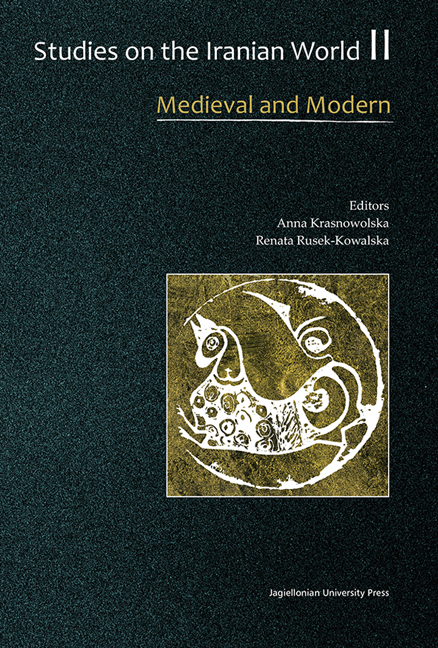Book contents
- Frontmatter
- Contents
- Foreword
- Linguistics
- Literature
- Religion
- History
- Arts
- The Reception and Illustration of Hafiz in Mid-Seventeeth-Century Iran
- Al-Muqaddasi's Ahsan al-Taqasim fi Ma‘rifat al-Aqalim and the Perception of the Built Environment in the Tenth Century
- Quelques réflexions autour d'un dessin de Michel François Préaux – peintre de la mission du général Gardane en Perse (1807–1809)
- Le cinéma de Kiarostami en prise sur le cinéma de Rossellini et Godard : rencontre, échange, superposition
- Where is Anna? What Happened to Elly? – Asghar Farhadi Rewrites and Re-Veils Michaelangelo Antonioni
- Social and Cultural Studies
The Reception and Illustration of Hafiz in Mid-Seventeeth-Century Iran
from Arts
Published online by Cambridge University Press: 12 January 2018
- Frontmatter
- Contents
- Foreword
- Linguistics
- Literature
- Religion
- History
- Arts
- The Reception and Illustration of Hafiz in Mid-Seventeeth-Century Iran
- Al-Muqaddasi's Ahsan al-Taqasim fi Ma‘rifat al-Aqalim and the Perception of the Built Environment in the Tenth Century
- Quelques réflexions autour d'un dessin de Michel François Préaux – peintre de la mission du général Gardane en Perse (1807–1809)
- Le cinéma de Kiarostami en prise sur le cinéma de Rossellini et Godard : rencontre, échange, superposition
- Where is Anna? What Happened to Elly? – Asghar Farhadi Rewrites and Re-Veils Michaelangelo Antonioni
- Social and Cultural Studies
Summary
SUMMARY
While an extensive body of scholarship has been devoted to the ghazals of Hafiz, two areas of inquiry that remain under-studied are the historical reception of Hafiz's poetry and the intersection of Hafiz and the visual arts. This paper aims to briefly explore these twin lacunae by focusing on pictures from two illustrated Divan of Hafiz manuscripts, produced in Iran ca. 1640–1650.
The importance of the poetry of Khwaja Shams al-Din Muhammad Hafiz-i Shirazi (1320s-1390 CE) to Persian culture is difficult to overstate. Since the early twentieth century, Hafiz's poems have generated an extensive body of scholarship, focusing on three main areas: the poet's life and historical context, the establishment of a divan-i sahih (or ‘true Divan,’ trimmed of all its accretions), and the critical analysis of individual ghazals. Two other topics, however, feature less prominently in the scholarly literature: the historical reception of Hafiz's poetry (particularly following the Timurid era) and the intersection of Hafiz and the visual arts. This essay addresses these two lacunae in Hafiz studies by focusing on the ways that artists of the mid-seventeenth century gave pictorial form the poet's ghazals in illustrated manuscripts of his Divan. Regarding reception and illustration as interrelated subjects of inquiry, this paper aims to demonstrate how later Safavid-era artists’ visualizations of Hafiz's ghazals reflect ways that contemporary readers interpreted and appreciated his poems.
Two intact, mid-seventeenth-century Divans of Hafiz (Topkapi Saray Library Museum, H. 1010 and Chester Beatty Library, Per. 299), which form the focus of this study, share several characteristics. The manuscripts have comparable dimensions and share an unusually large quantity of illustrations, with almost one picture per ghazal. In each example, full text pages appearing on the verso (b) side of folios face illustrations on the recto (a) side of the following folios, prompting comparison to muraqqa's (albums), in which calligraphies and pictures often alternate. The illustrative programs of each of the manuscripts, comprised entirely of tinted drawings, appear to be executed in three distinct ‘hands.’ Several pictures from TSMK H.1010 are inscribed with artists’ names, while CBL Per. 299 lacks such inscriptions; nonetheless, the stylistic similarities of the two manuscripts’ illustrations suggest that the same group of artists may have been responsible for both programs.
- Type
- Chapter
- Information
- Studies on the Iranian WorldMedieval and Modern, pp. 231 - 242Publisher: Jagiellonian University PressPrint publication year: 2015



